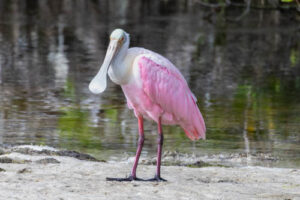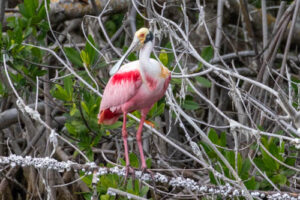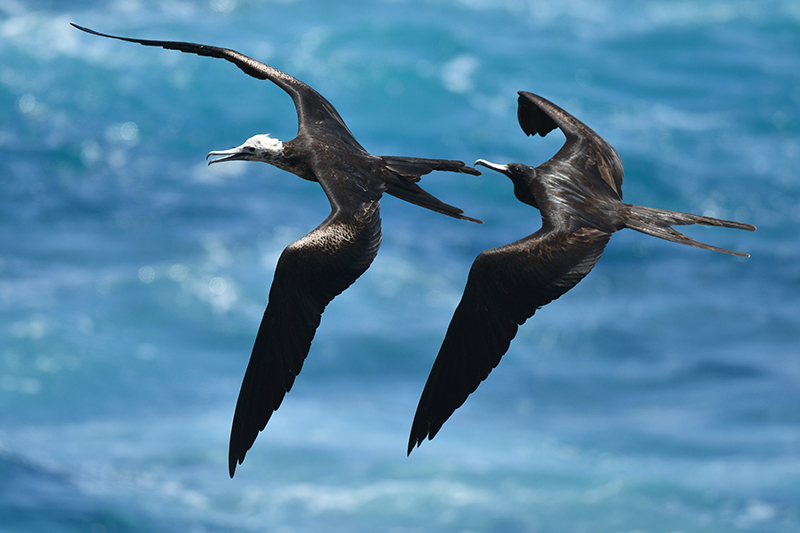Our close friend Dr. Ken Kelly has turned my lovely bride into a birdwatcher and member of the Audubon Society.
She celebrated the end of our 2023 teaching tour with a few days on beautiful Sanibel Island in Florida, where she photographed many of the thousands of birds she saw, one of which was the striking Roseate Spoonbill you see in the photos.


But her high point of the trip was a bird too far away to capture with the lens she had on the camera at that moment, so she could take the photo only in her memory. A true rara avis.
It was a frigate bird, the proper term for which I’m told is The Magnificent Frigate Bird. The photo you see above had to be found on the internet.
Apparently, its name comes from the fact that it spends most of its time at sea and is rarely near land.
I can sympathize with her not being able to get the shot in the fleeting moment when the frigate bird presented itself to view. Back when I hunted a lot more with a gun than with a camera, there were times I saw splendid specimens that I couldn’t guarantee a clean kill on at the distance presented, so I just took my finger off the trigger and was thankful that I could at least see the beautiful thing in its native habitat.
I am sad I wasn’t there to see the rare bird with her. My Audubon moment would have probably sounded like “Odd. Ooh. Bon!”
When she gave me the history of the frigate bird, which I’d never heard of before, my first reaction was “So, they call it that because so many birdwatchers look for it and never find one that they finally give up and say ‘Frig it’?”
The Princess was not amused…but I’m very happy that she got to see it.



My Frigate bird was a magnificent Royal bull elk on an archery hunt in Colorado’s Wiminuche wilderness. I had slipped and dropped my bow and bent the springy rest and didn’t have a chance to resight it before the bull walked into a narrow clearing about 60 yards away downhill. I was comfortable shooting at that range, but didn’t want to chance wounding a magnificent animal with a possibly off rest. The bull walked into the black timber and though I stalked him the rest of the day, I never saw him again. I hope he spread his genes far and wide. He lives forever in my memory.
I was hunting elk with my son at Broken Ridge in the S Wah Wah mountains in SW UT. We were on a rocky point nearby when he bumped on rifle rather firmly on a rock. Ihe wasn’t worried. I was. I inspired we take what was essentially a day and a half to get out, sight it in and get back. Good decision as it was significantly off target. It was bad enough he certainly would have missed his first elk, a spike as we had spike tags. He took it at 220 yards or so. It would have been a clean miss. He was in CO this past season on an archery hunt. To no avail. A guide picked their camp as they did not know the area and had no time yo scout. The guide packed most of their gear in. They hunted on their own. My son is great at calling, glassing, reading the terrain and elk. He has a few kills and video of bulls & cows at less than 45 yards. The elk were silent and missing. He saw one elk and heard none.
Frigate birds are pretty common in the Caribbean and often seen soaring up high in the sky. They are also called man o’ war birds since they somewhat frequently attack other sea birds and steal a meal from them. And they are fast… some say the combination of those traits resulted in the ‘frigate’ moniker… as in a fast man o’ war…
Bird watching is a very pleasant activity, and great observational training for learning to see details. As you allude to, it can be very frustration as well, since a lot of birds don’t sit still long enough to pick out the details needed to make a species level ID (esp. warblers, sparrows, hummingbirds, etc.). That’s probably why Audubon shot or netted the birds that were the subjects of his famous paintings!
My mom and dad were both avid birders and Audubon Society members, and also avid bird hunters – a great example of how hunting and conservation go hand in hand. Many would be the time we would be driving down the road when suddenly mom would blurt out, “STOP THE CAR! There’s a bird back on that tree I need to look at!” So I got indoctrinated into both birding and hunting early on, and the eye training I got served me well in making out differences in small details when observing terrain.
Maybe we should start a group called the National Tactical Ornithology Association – but that might get confused with the other NTOA…. one other person in the training community would be a good charter member – Pat McNamara is an avid birder.
Always kept an eye out for frigate birds when offshore in South Florida or the Keys. They tended to follow large game fish and wait for the baitfish that were killed or crippled by the marlin, sails, tuna, etc…
They usually come in closer if there’s bad weather (hurricane) out there. We usually see them hovering over the beach when it’s bad weather in the Gulf.
I’m a photography hobbyist and I love living in Florida. There is an incredible variety of birds and insects. If I want something easier to photograph, I can always resort to alligators. Another favorite subject is horses. Living in horse country, outside of Ocala, there are a lot of horse farms and show venues. I’ve been living in the same house for over 30 years and they were kind enough to build the World Equestrian Center just 6 miles away. A lot of their events are free to spectators and they allow spectators to bring their cameras, including DSLRs.
I dropped my Audubon Society membership in 2020 due to their extensive contributions to Democrats (https://www.opensecrets.org/orgs/national-audubon-society/totals?id=D000045030).
I doubled my contribution to the Cornell Lab of Ornithology instead (https://www.birds.cornell.edu/home/)
Just FYI
“Frig it.”
As in “Awe, frig it.”
This reminds me of standing with the director of pharmacy and hospital president many years ago. The topic of discussion eludes me now. I do recall expressing by disdain by firmly stating “Awe, frig it.”
Both were rather stuned. My boss the director, asked, in a shocked voice, “What?”
I had to go into definitions. “A war ship with multiple masts.” I then added some fun facts about various sailing ships. My favorite being “Fun fact. On a ketch, the mizzen stands forward of the rudder post (the vertical shaft connecting the rudder to the tiller or wheel); on a yawl, it’s aft of the rudder …”
I distracted them enough I suffered no consequence for my expression of dissatisfaction with our conversation.
On a different topic, I still recall that Maine monster. He was lucky I had my father’s Model 94 in Winchester .32 spcl. The gun he had put a 4 power scope on. I had used it to take some deer but I had not used it to hunt with the scope. It turns out taking a snap shot on a monster buck in full bound shot in heavy woods with a scope was not as easy as similar shots I had made with success. He charged down into the swamp on the north side of Fry Mountain. I was sure he stopped behind a stand of trees at about 125 yards. And with the 4 power, I was almost sure I could see an eye peeking between the trees. I was never more tempted to take a shot at a target I couldn’t be 100% certain about. I resisted. Waited. 20 minutes later I started moving. I had lost sight of the eye some minutes before. Not buck jumping at my movement, I headed for the clump of trees. And there, on the other side was probably the biggest, and warmest pile of fresh, steaming … well. You know. He was there! He impressed me in his size an cunning!
We see the Frigate birds at Grand Isle, La., often during the spring and summers. The locals there called them Storm Birds as they were often soaring the thermals during thunderstorm season. They are quite graceful to watch. I seem to recall reading that they can fly for days without landing. Although they are often waaaay up high, probably 3 to 4 thousand feet up, it’s also not unusual to seem them coasting the beaches at only a few hundred feet, allowing very good sighting.
Very good plays on words, Mas! Even a little French thrown in there!
My wife and I saw Frigatebirds in Costa Rica. It’s hard to miss that forked tail!
Ah, the elusive spoonbill flamingo…
Comments are closed.